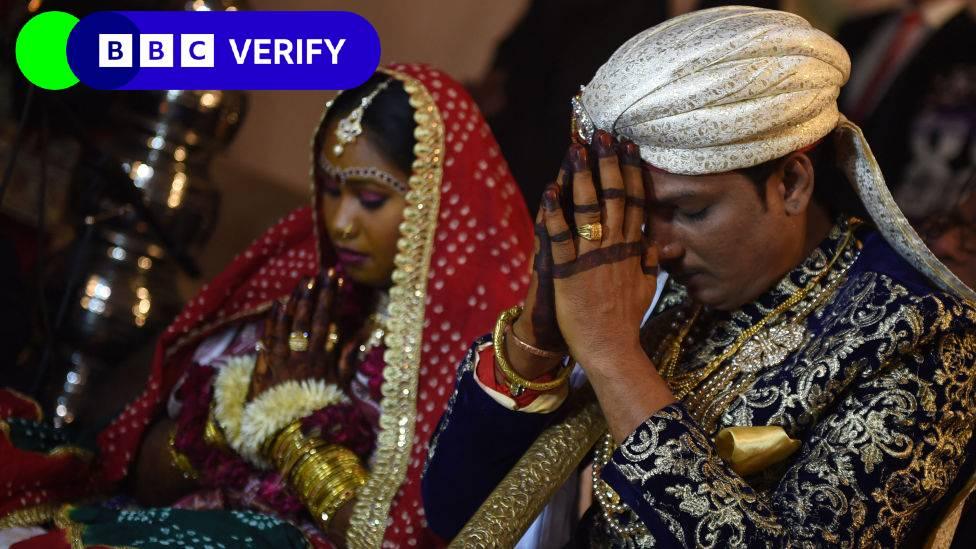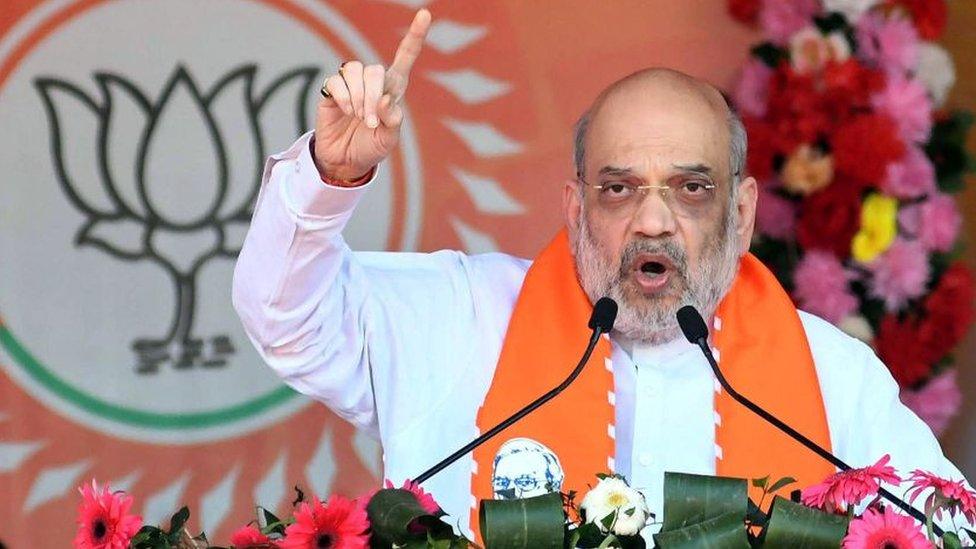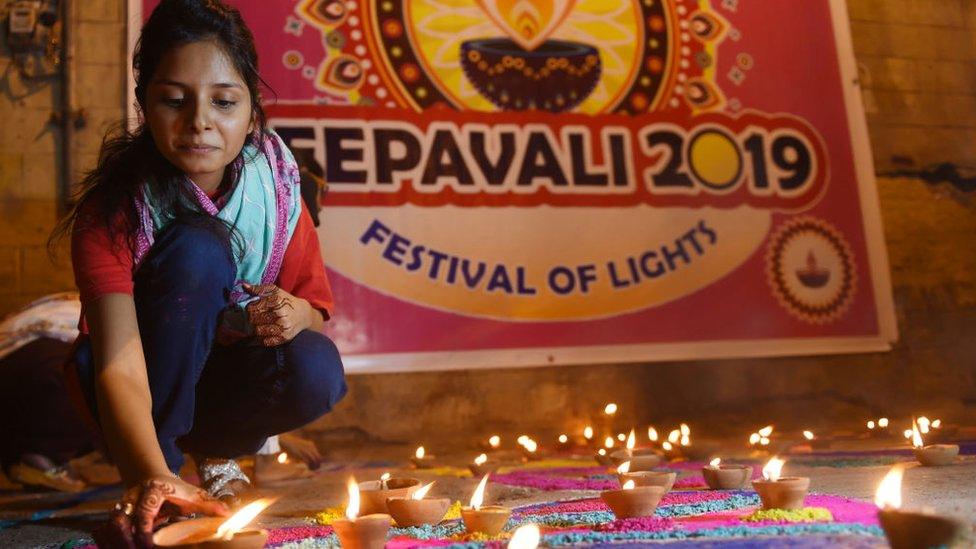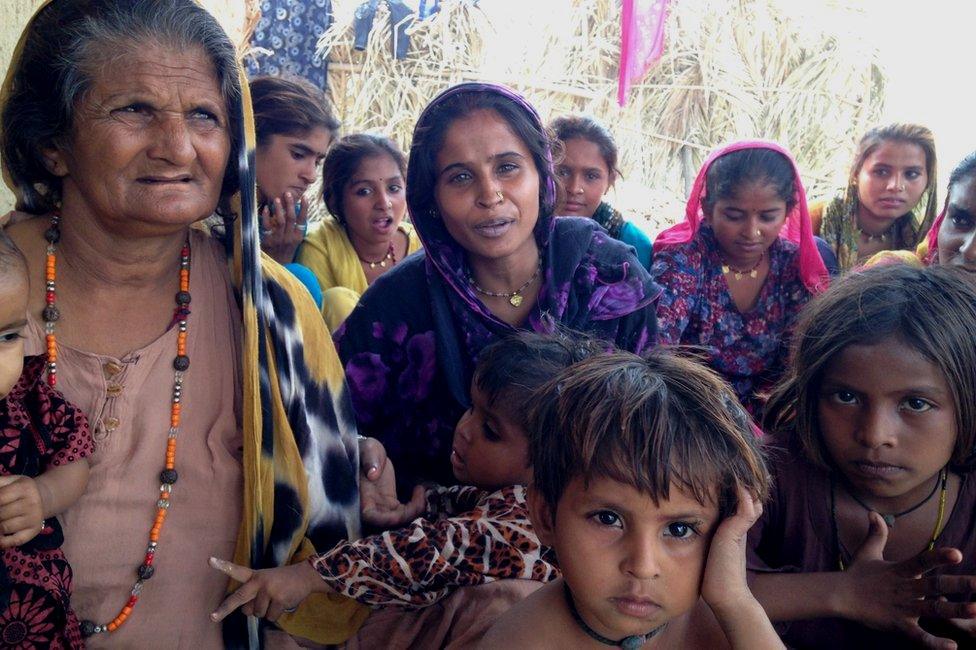CAA: Are India's claims about minorities in other countries true?
- Published

Hindu marriage was legalised in Pakistan in 2017
The Indian government has decided to enact a controversial law offering citizenship to non-Muslim minorities from three neighbouring countries.
Hindus, Sikhs, Buddhists, Jains, Parsis and Christians who have entered India illegally before 31 December 2014 can apply for citizenship if they can prove they originate from Muslim-majority Pakistan, Bangladesh or Afghanistan.
The law, known as the Citizenship Amendment Act (CAA), has been criticised as discriminatory because the same right has not been granted to Muslims who have come to India from other countries.

Home Minister Amit Shah says non-Muslim groups are persecuted
The government argues that minorities in those Muslim-majority countries are dwindling, and that they face persecution on the grounds of their faith.
"I believe it is our moral and constitutional responsibility to give shelter to those who were part of Akhand Bharat and suffered religious persecution," says Home Minister Amit Shah.
Akhand Bharat is a historical term referring to the idea of a greater India, and understood to include India, Afghanistan, Pakistan, Bangladesh, Bhutan, Maldives, Nepal, Myanmar, Sri Lanka and Tibet.
So what is the situation facing non-Muslims in neighbouring states?
How many Hindus and other non-Muslims?
Home Minister Amit Shah said in December 2019 - when the CAA was passed in parliament - that Pakistan's non-Muslim population had dwindled dramatically since independence in 1947, when British India was partitioned.
Partition resulted in the mass movement of non-Muslims (Hindus, Sikhs and others) from the newly-created Pakistan to India - and of Muslims who were living in India to Pakistan.
Mr Shah cited a figure of 23% for non-Muslim minorities in Pakistan in 1947, which he said had reduced to just 3.7% by 2011. In March this year, Mr Shah cited the same figures again - but this time said they were just for Hindus in Pakistan.
He has also talked about a decline in the Hindu population of Bangladesh, which was formerly east Pakistan until 1971 when it became a separate country. In August this year, Mr Shah said the figure was 27% at the time of partition, but had now gone down to 9%.
It's not clear where these figures have come from.
Data from a 1951 census (four years after partition) shows a Hindu population of both parts of Pakistan (east and west) of just over 23%. The vast majority were in East Pakistan (now Bangladesh) - and just 1.6% in West Pakistan.
Data from more recent censuses shows that the size of the Hindu minority in what was West Pakistan has not really changed greatly.
However, in Bangladesh (formerly East Pakistan), the data does suggest the Hindu population has fallen significantly in the years since partition - from around 22% in 1951 to 8% in 2022.

Diwali celebrations in the Pakistan city of Karachi
There are other non-Muslim religious minorities in Pakistan and Bangladesh, such as Christians, Buddhists, Sikhs, and Parsis.
And in Pakistan, there are also Ahmadis, who were declared non-Muslim by the government in the 1970s, and are estimated to be around four million strong, making them the largest religious minority in the country.
In Afghanistan, non-Muslim groups include Hindus, Sikhs, Bahais and Christians, and make up less than 0.3% of the population.
In 2023, there were fewer than 100 Sikhs and Hindus left in Afghanistan despite the Taliban reportedly giving assurances for their safety, according to an official US report., external
What's the official status of non-Muslims?
The Indian government's citizenship act states: "The constitutions of Pakistan, Afghanistan and Bangladesh provide for a specific state religion. As a result, many persons belonging to Hindu, Sikh, Buddhist, Jain, Parsi and Christian communities have faced persecution on grounds of religion in those countries. "
It's true that the state religion of Pakistan is Islam. Afghanistan is also an Islamic state.
In Bangladesh, the situation is more complicated. The country came into being in 1971 with a secular constitution, but in 1988 Islam was made the official state religion.
A lengthy legal battle to get that reversed ended in 2016 when Bangladesh's top court ruled that Islam should remain the state religion.
However, all these countries have constitutional provisions stating that non-Muslims have rights and are free to practise their faith. And individual Hindus have risen to prominent positions in both Pakistan and Bangladesh, notably as chief justices in the two countries.
Do minorities face discrimination?
In practice, non-Muslim minorities do face discrimination and persecution.
Human rights group Amnesty International has pointed to Pakistan's blasphemy laws, which it says "are vaguely formulated and arbitrarily enforced by the police and judiciary in a way which amounts to harassment and persecution of religious minorities".

A group of Hindus from Pakistan living at a camp in Delhi
Pakistani Hindus who moved to India in recent years have told the BBC they face social and religious discrimination, with a particular issue being the targeting of Hindu girls in Sindh province.
But it's also true that Ahmadis, who are not covered by India's citizenship act, face discrimination for their beliefs as they are regarded as heretical by the Muslim majority in Pakistan.
In Bangladesh, there are various reasons for the decline in the proportion of Hindus over the years.
The better-off Hindu population have had their homes and businesses targeted, sometimes in attempts to get them to leave so their land or assets can be taken over. Hindus have also been the targets of attacks by religious militants.
The Bangladesh government has previously rejected India's claims about minorities being targeted. Former foreign minister Abdul Monem had told the BBC in 2019: "We don't have examples of minorities being persecuted in this country."
Correction (11 October 2024): This article stated that Amit Shah said Pakistan's non-Muslim population had dwindled since 1951. This has since been corrected to state that he said the non-Muslim population had dwindled since 1947.
